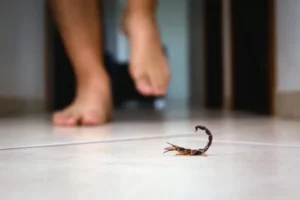Home / Blog / How to Get Rid of Webbing Clothes Moths
How to Get Rid of Webbing Clothes Moths

Scientifically reviewed by Daniel Baldwin, BCE, CCFS, CP-FS
-Published on June 5, 2023
-Updated on June 9, 2023
The webbing clothes moth is the most common fabric moth in the U.S. These small moths are weak flyers that prefer dark areas—making your closets, drawers, and linen chests susceptible to infestation. Webbing clothes moth larvae get their nutrition from fabric, including wool and other natural fibers. If you suspect you’re dealing with a webbing clothes moth infestation, read this guide to learn everything you need to know about control, prevention, and treatment of these pests.
What are webbing clothes moths?
Webbing clothes moths are a common species of fabric moth. The adults are pale gold with reddish-golden hairs on their heads and a row of golden hair on the wings. They have weak wings and aren’t commonly seen flying around homes like their counterparts, food moths or grain moths. They’re around ¼-inch long and have a distinct fluttering pattern when they make short flights. They stay near their food source and prefer hiding, especially when they feel threatened or disrupted.

Life cycle of webbing clothes moths
Female webbing clothes moths lay about 40 to 50 eggs over two to three weeks, and die after completing their egg-laying routine. Males outlive the females, continuing to breed their entire adult lives. The eggs are attached to fabric threads with an adhesive secretion, and they hatch after four to ten days in warm weather.
The larvae molt from five to 45 times depending on temperature, conditions, and available food. This larval period can last 35 days to 2 ½ years. The larvae are a shiny white color with dark capsule heads. They spin webbing as they feed, creating a silken feeding tube or tunnel. Webbing clothes moth pupation occurs in a silken cocoon that’s usually connected to the fabric. Their pupation lasts eight to ten days in the summer and three to four weeks in the winter. Heated buildings can accelerate their pupation process.
Webbing clothes moths vs. casemaking clothes moths
Webbing clothes moths and casemaking clothes moths are very similar species with many shared habits. However, there are a few distinctions to help to identify the exact type of clothing moth you have in your home. Webbing clothes moth larvae leave behind a small webbed shelter the same color as the fabric they are eating.
Casemaking clothes moth larvae also create a silken webbing while eating. However, they carry this material with them as they consume fabric and use it to build their cocoon when the time comes to pupate.
Signs of a webbing clothes moth infestation
The most easily identifiable sign of an infestation is small holes in your stored clothing. This commonly occurs in items like sweaters or knit materials made from animal-based fibers such as fur, wool, cashmere, or alpaca. These fibers are often found in other household fabrics, including rugs, chairs, curtains, blankets, scarves, tapestries, stuffed animals, or knitting yarns. You may also notice dead larvae or empty cocoons in and around the areas where they have been feeding.
How to get rid of webbing clothes moths
If you suspect you have webbing clothes moths in your home, there are some measures you can take to help control their spread and keep your clothing free of damage.
- Dry cleaning. The process of dry cleaning clothing kills any moths and helps to remove moisture to make it less appealing.
- Freezing. Keep your clothing or household fabrics below 32 degrees Fahrenheit for several hours to kill existing eggs or larvae.
- Hot washing. If your clothing can withstand it, running them through a hot water cycle for at least 30 minutes may help kill the moths, larvae, and eggs.
- Cleaning. Vacuuming, general household cleaning, and seasonal airing of carpets and stored clothing can make webbing clothes moths look for new places to hide.
Pest control services
The best way to treat webbing clothes moths is by hiring a professional pest control service like Hawx Pest Control. With proven methods, qualified technicians, and the best products and services available, Hawx is the undisputed leader in pest control solutions. We offer safe and affordable treatment for your current problem and address potential threats before they happen. Call us today for a free estimate and get your pest problem under control.
Related Articles
Visit our blog to learn more.
→






